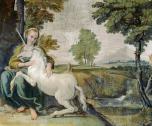Posted on February 1, 2015, and tagged as
The Mass is a series of rites, prayers, music and actions that make up two liturgies (the Word and the Eucharist) through which we encounter the risen Lord. We begin the Liturgy of the Eucharist with two actions: preparing the altar and presenting the gifts.
The early church did them both simply. The altar was covered with a linen cloth (called a corporal) and the ministers and people placed bread and wine on it.
Simplicity didn't last. By the beginning of the Middle Ages the corporal had grown. It became so large that two deacons had to manhandle it into place by throwing it to each other across the altar. The time for preparing the altar also changed. Sometimes it was done during the readings and sometimes after. A chalice was always placed on top, but a purificator (the cloth used to clean the chalice) didn't appear regularly until the 16th century. By then the corporal shrank in size.
As for the gifts, we know from practices in ancient Rome that the people of the early church who supplied bread and wine brought them both to the altar themselves. By the 3rd century the deacons presented the people's gifts to the bishop, and a century later the bread was presented by Rome's aristocracy while a deacon presented the wine.
Outside of Rome the procession was a larger affair. Oil, candles, bread, wine, wheat and grapes were brought by people who were then expected to receive communion later in Mass. But as the number of people receiving communion declined in the Middle Ages, the procession was replaced by the giving of money.
Today, we've returned to the simpler preparation rite and gift procession. After the Universal Prayer, the priest, deacon or acolyte places a corporal, purificator, chalice with pall (a cover for the chalice) and the Roman Missal on the altar, after which members of the congregation bring bread, wine and gifts for the church and poor to the presiding priest.
At this point in mass the focus changes from the ambo to the table of Christ's sacrifice, in which we express a desire to participate by offering our gifts of bread and wine.
This originally appeared in the Church of St. Monica's weekly parish bulletin.







